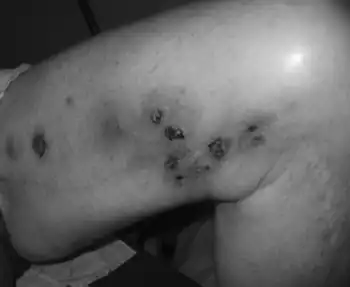Mycobacterium haemophilum
| Mycobacterium haemophilum | |
|---|---|
| Scientific classification | |
| Domain: | Bacteria |
| Phylum: | Actinomycetota |
| Class: | Actinomycetia |
| Order: | Mycobacteriales |
| Family: | Mycobacteriaceae |
| Genus: | Mycobacterium |
| Species: | M. haemophilum |
| Binomial name | |
| Mycobacterium haemophilum Sompolinsky et al. 1978, ATCC 29548 | |
Mycobacterium haemophilum is a species of the phylum Actinomycetota (Gram-positive bacteria with high guanine and cytosine content, one of the dominant phyla of all bacteria), belonging to the genus Mycobacterium.
Description
Short, occasionally curved, gram-positive, nonmotile and strongly acid-fast rods.
Colony characteristics
- Nonpigmented and rough to smooth colonies.
Physiology
- Media have to be supplemented with 0.4% haemoglobin or 60 μM hemin (factor X) or 15 mg/ml ferric ammonium citrate respectively, but not with FeCl3 or catalase.
- Slow growth on Löwenstein–Jensen medium or Middlebrook 7H10 agar at 32 °C within 2 to 4 weeks.
- Growth slower at 25 °C and 35 °C and absent at 37 °C.
- Strictly intracellular growth in tissue cultures of fibroblasts.
Differential characteristics
- Unique among mycobacteria in its requirement for hemin or ferric ammonium citrate for growth.
Distribution.
Type strain
First isolated in Israel from a subcutaneous granuloma from a patient with Hodgkin's disease. An environmental reservoir is presumed. Strain ATCC 29548 = CCUG 47452 = CIP 105049 = DSM 44634 = NCTC 11185.
Human infection

Clinical presentation: multiple skin nodules occurring in clusters or without definitive pattern, commonly involving the extremities. Abscesses, draining fistulas and osteomyelitis may be associated with the nodules. Paediatric patients with localised cervical lymphadenopathy.
Infects patients with suppressed immune systems.[1]
Notes
References
- Sompolinsky, D.; Lagziel, A.; Naveh, D.; Yankilevitz, T. (1978). "Mycobacterium haemophilum sp. nov., a New Pathogen of Humans". International Journal of Systematic Bacteriology. 28 (1): 67–75. doi:10.1099/00207713-28-1-67.
External links
- Type strain of Mycobacterium haemophilum at BacDive - the Bacterial Diversity Metadatabase Archived 2017-02-02 at the Wayback Machine